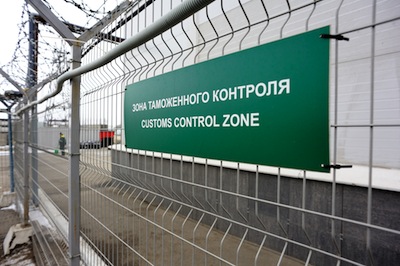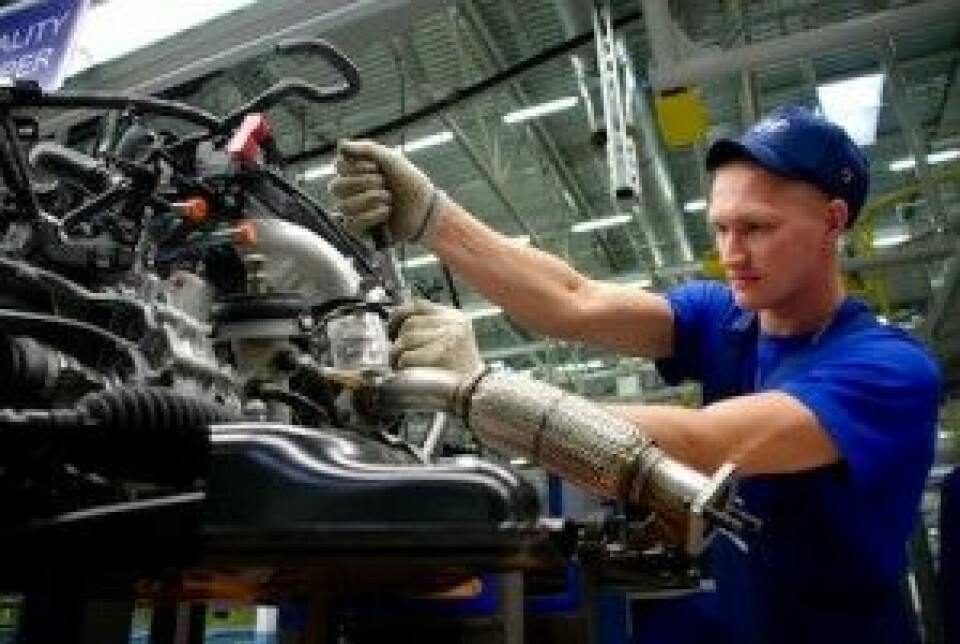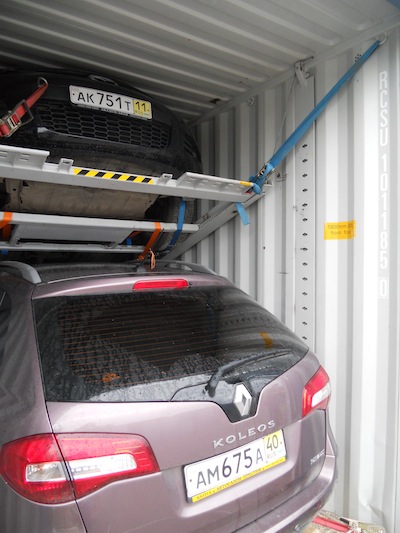Are Russian import tariffs going back to the USSR?
UPDATE: Since publication, there have been further developments, including the decision by the Ukrainian government to increase excise duties. Read more here.
Despite joining the WTO or promoting trade, Russia and its neighbours retain a highly complex set of import tariffs and barriers. But could political tension and economic pressure force more liberalisation?
 When you consider the complex web of protective fees and duty barriers involved in importing vehicles to Russia, Ukraine, Kazakhstan and other countries that make up the Commonwealth of Independent State (CIS), it’s hard to imagine that it has been more than 22 years since the end of the Soviet Union – and nearly two since Russia joined the World Trade Organisation (WTO).
When you consider the complex web of protective fees and duty barriers involved in importing vehicles to Russia, Ukraine, Kazakhstan and other countries that make up the Commonwealth of Independent State (CIS), it’s hard to imagine that it has been more than 22 years since the end of the Soviet Union – and nearly two since Russia joined the World Trade Organisation (WTO).
With so-called ‘recycling’ or ‘utilisation’ fees, luxury duties and excise taxes, along with already high customs tariffs, import costs are punitive throughout the region. The Ukraine has recently implemented a special import duty and a recycling fee, while rules vary even among the ‘Eurasian Customs Union’ of Russia, Belarus and Kazakhstan. Countries considered candidates to join the customs union, such as Uzbekistan and Kyrgyzstan, are far from open markets, even between their CIS neighbours.
These countries are not alone in maintaining or erecting new import barriers and privileging vehicle production on their home turf. China, India and Brazil are all highly protected markets. Argentina has recently restricted vehicle imports outright, part of efforts to tackle a currency crisis. The Southeast Asian trading bloc has lowered tariffs between members, but markets like Indonesia, Thailand and Malaysia have restrictions that encourage local manufacturing. Despite all of its difficulties, Russia remains an immensely important market for the European automotive industry, with a thriving trade in importing vehicles and automotive parts, as can partly be seen by Russia's investment in its ports. Considerable potential remains in neighbouring Ukraine and Central Asia as well.

In recent years there have also been efforts made to lower or phase out certain controls; however, many governments in the region tend to loosen restrictions with one hand and tighten them with the other. For example, even as Russia joined the WTO in 2012 and agreed to a phased reduction in import tariffs, the government slapped on a recycling fee for imports that made up for reductions. The Ukraine and Belarus have followed suit. Russia will also subsidise OEMs and tier suppliers that meet its localisation and production criteria beyond the savings that the entire market should see in lower duty reductions over the next five years.
The march of one step forward, two back has continued this past year. Russia has balanced its utilisation fee to some degree by levying it to local producers, however it will also offer more subsidies to domestic players. Uzbekistan has reduced excise tax when importing cars from Russia from 5% to 2%, while it has also reintroduced a 3% fee for Ukrainian and Russian imports that had previously been abolished. The net cost effect is nil, except for more bureaucracy as importers pay not one but two different taxes in two different ways.
But with sales predicted to fall again this year in Russia and its neighbours, some experts say that fewer restrictions will promote competition, which should benefit consumers, importers and logistics providers.
 Andrei Slepnev, a minister responsible for the customs union, says that pressure from the WTO and the EU has forced Russia to modify its vehicle recycling policy
Andrei Slepnev, a minister responsible for the customs union, says that pressure from the WTO and the EU has forced Russia to modify its vehicle recycling policy
Following pressure from the EU and WTO, the Russian government has changed aspects of its utilisation fees. While previously the fee applied only to foreign imports, from January 1st this year it applies to all carmakers, including domestic brands and those with local plants.
"We had to change [the recycling fee] under pressure of the European Union, which has initiated a judicial procedure, and demanded that the WTO assemble a team of expert-referees to check whether the utilisation fee complies with the WTO rules,” says Andrei Slepnev, the Minister for trade of the Eurasian Economic Commission, the governing body of the customs union. “Europeans have claimed that the payment of the utilisation fee discriminated against their producers."
However, this change may not be a total ‘victory’ for the EU or importers. Firstly, there is no reduction in the cost of importing a vehicle. Rather, Russian-based manufacturers must also pay the fee – albeit at a much lower rate (see table). Furthermore, early in 2014 Russia announced that it would offer subsidies to domestic producers of around 270 billion roubles ($7.75 billion) through 2016. Some experts suggest this is a way to compensate for the utilisation fee.
Engine size Domestic Imported
0-1.5 litres 0.5 4.1
1.5-1.8 litres 1 5.85
1.8-2.5 litres 1.5 7.8
2.5-3 litres 1.8 13.8
3-3.5 litres 3 19.3
3.5 litres plus 3.6 30.7
*Utilisation fee is estimated by mutiplying the coefficient by RUB20,000 ($575)
Nevertheless, according to the Russian Automobile Union, the slightly more level playing field should increase demand for imported cars, particularly for lower cost vehicles.
"The cost of the utilisation fee traditionally has been included in logistics costs, resulting that imported cars had an additional price burden in comparison with Russian brands,” says Valery Ivanov, spokesperson for the Russian Automobile Union. “Despite the fact that utilisation fee rates are still unequal for Russian and foreign manufacturers, innovation will improve competition, especially for vehicles competing with Lada."
Perhaps more important than the domestic fee, the Russian government is also allowing foreign carmakers to create their own recycling plants for vehicles, which will allow them to avoid the fees altogether (albeit following large capital outlays).
The countries of the Eurasian Customs Union are also working on unifying all custom and utilisation fee legislation between Russia, Belarus and Kazakhstan by 2016. By that time the union also may be expanded to include Armenia and Kyrgyzstan.
Uncertainty in Ukraine
Ukraine, which is facing a political crisis amid protests in the capital Kiev, is also considering throwing off some protective measures. Ukraine imposed special duties on imports of new cars in April last year to protect its domestic producers, including a duty of nearly 6.5% on the import of cars – regardless of origin country – with a petrol engine capacity of 1-1.5 litres and double that for larger engines.
Last year Ukraine also introduced a Russian-style utilisation fees for imported cars (see table). The result of both measures has been an increase in import and logistics costs of up to 20%.
According to the general director of the All-Ukrainian Association of Auto Importers and Dealers (VAAID), Oleg Nazarenko, the fees have helped neither domestic car producers nor consumers. Overall vehicle sales in 2013 dropped nearly 30% compared to 2012. VAAID’s message seems to be reaching government, as Ukraine’s Ministry of Economic Development is considering cancelling the special duty, says Nazarenko.
"These options have already been discussed in Brussels, when Ukraine was negotiating the signing of the Association Agreement with the EU," says Nazarenko.
"Many dealers have simply refused to import cars that fall under the special duty. However, the abolition of the duty would lead to an increase in the assortment of imported cars, with the obvious decrease of costs that would follow" – Oleg Nazarenko, Ukrainian Association of Auto Importers and Dealers
Although that association agreement has since been cancelled in favour a deal with Moscow – which has led, in part, to the recent protests in the country – the options for scrapping the duty are still apparently on the table.
“In the first scenario, special duties will initially be lowered by 50%, and then for three years gradually reduced to 0%,” says Nazarenko. “The second scenario assumes a gradual reduction of the tax for several years. In a third scenario, the special duty is cancelled immediately.”
Engine size New Used
Electric 0.86 1.72
0-1 litres 0.86 1.72
1-2 litres 1.34 2.68
2-3 litres 2.56 5.12
3-3.5 litres 3.47 6.94
3-3.5 litres plus 5.5 11
*Utilisation fee is estimated by mutiplying the coefficient by UAH5,500 ($645)
Nazarenko says that it is difficult to estimate how the abolition of the duty might improve the cost of vehicles. "Some importers increased prices for their cars while some did not and pay the cost of the new duty,” he says. “Many dealers have simply refused to import cars that fall under the special duty. However, the abolition of the special duty would lead to an increase in the assortment of imported cars, with the obvious decrease of costs that would follow.”
VAAID has also appealed to Ukraine’s embattled president, Viktor Yanukovych and the country's Supreme Council with proposals to cancel the recycling fee, which the association also regards as a protectionist measure with no overall industry benefits. VAAID points out that many dealers avoid this fee by importing cars under categories that are not subject to utilisation fees, and then re-registering the cars.
Potential reductions in Kazakhstan
A positive sign has come from Kazakhstan, which has expressed an intention to lower duties on car imports. According to Timur Zhaksylykov, vice-minister of economy and budget planning, Kazakhstan will decrease its 30% import duty after it joins the WTO, which is expected to be this year or next.
Although many tariff barriers remain in Russia, one area where it clearly wants to open up more than its neighbours is port infrastructure. According to Sergey Vovk, the director of the Centre for Transport Strategies for Ukraine, Russian seaport infrastructure plans until 2020 are aimed at increasing the turnover and transhipment of goods through Russian ports in the Baltic and the Black Sea, particularly at the expense of Ukrainian and Baltic country ports.
Vovk adds that Russian ports should benefit from a projected rise in railway transport from Ukraine and the Baltic countries. The Russian government recently froze tariffs and cancelled the right of the Russian Railways to increase prices even marginally.

"For example, in Belarus the registration of one unit of shipment on a railway platform ranges from 15-45 minutes, whereas in Ukraine it is from several hours to several days," he says.
According to Sergey Vovk, a similar delay is observed in Ukrainian ports, resulting in higher logistics costs than in neighbouring countries.
"There will be some reduction of customs duties over a phased period,” he says. “We hope that the reduction will be finished in three years after the joining of the WTO.”
Zhaksylykov says that negotiations with the WTO are in the final stage, although he doesn’t clarify how much the reduction would be. However, according to a source in the state commission on adopting national legislation to WTO rules, duties would probably come down to around 10% over a phased period. According to the source, such duties would eventually be harmonised across the customs union, however the issue remains under discussion.
Local matters more
Russia's industrial strategy continues to encourage foreign automotive companies to increase local production. The move to allow these companies to set up their own utilisation centres continues that policy. Toyota’s top management has already put forward a proposal to build a recycling centre in the Moscow region. It would be the first of its kind in Russia, according to a Toyota spokesperson.
Russia’s Ministry of Industry is responsible for the development of vehicle recycling centres, and it looks like it could be big business. According to an announcement by the ministry, these facilities could appear in every region of the country, including every city with a population more than 500,000 people. A source at the ministry says that, in total, the Russian government expects around 24 utilisation plants, most of them belonging to foreign brands, with investments that could reach up to $8 billion. Similar measures could also be approved across the customs union.
While recycling plants could reduce import costs, more local production is nevertheless expected across the region. According to Tariel Vasadze, honorary president of UkrAvto, a vehicle manufacturer and distributor in Ukraine, around 200 companies have been granted permission to assemble cars by knockdown kits in the country, which could lead to manufacturing growth of 500% in the coming years, he says. Vasadze sees Ukraine as a possible foothold for Chinese manufacturers, who are already increasing their production capacities in the region. However, with the political and economic situation in Ukraine uncertain, such projections could be very optimistic.
Nevertheless, a more active integration of the import regimes between Russia, Ukraine and its neighbours would encourage more manufacturing, in part thanks to the potential for export across the region, according to Anton Shapovalov, from automotive analytical agency RusAvto. Already this year, for example, GM announced that it would target more exports of the Chevrolet Niva out of its joint venture factory with Avtovaz in Togliatti, most of which go to Kazakhstan, thanks in part to stability in the customs union.
"We see that despite a not quite smooth political situation, most CIS countries are moving towards a liberalisation of customs and tariff policy, and a projected geographical expansion of the customs union,” he says. “Along with a better cooperation between Russia and Ukraine, including a recent meeting of the presidents, CKD [complete knockdown] plants in Russia's Kaliningrad Oblast or Cherkassy Oblast in Ukraine can become powerful platforms that will let carmakers strengthen their positions in the markets of Central Asian countries.”





